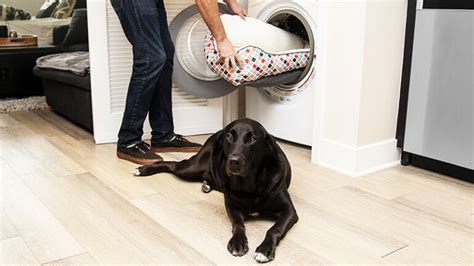Introduction:

Dogs, our furry companions, spend much of their time on their beds, which become breeding grounds for bacteria, allergens, and debris. Maintaining a clean and hygienic dog bed is crucial for the well-being of your pet and your family. This comprehensive guide will delve into the essential steps of washing and drying dog beds, ensuring optimal cleanliness and longevity.
1. Preparation: Assessing the Bed’s Material
a) Removable Covers:
– If your dog bed has a removable cover, detach it before washing.
– Check the care label for specific instructions.
b) Non-Removable Covers:
– Determine the bed’s material.
– Some materials, such as memory foam, require special cleaning.
c) Types of Materials:
– Canvas: Durable, machine-washable
– Fleece: Soft, absorbs moisture
– Microfiber: Hypoallergenic, quick-drying
– Cotton: Breathable, machine-washable
2. Pre-Treatment: Removing Debris and Loose Hair
a) Vacuuming:
– Use a vacuum cleaner to remove loose hair, dust, and other debris.
b) Brushing (for Non-Removable Covers):
– Using a soft brush, gently remove any remaining hair or debris.
c) Shaking Outdoors:
– Shake the bed vigorously outdoors to dislodge any stubborn dirt.
3. Washing: Selecting the Right Method
a) Machine Washing:
– For removable covers or machine-washable beds, use a large capacity washer.
– Choose the gentle cycle and cold water.
– Add a mild detergent specifically designed for pet bedding.
b) Hand Washing:
– For large or delicate beds, hand washing is recommended.
– Use a large tub or sink filled with cold water and mild detergent.
– Gently agitate the bed to remove dirt.
4. Drying: Preventing Mold and Odors
a) Air Drying:
– Hang the bed outside on a clothesline or drying rack.
– Ensure it’s fully dry before using.
b) Machine Drying:
– For removable covers or small beds, use the tumble dry setting on low heat.
– Remove the bed promptly to prevent shrinkage and damage.
c) Natural Drying:
– If possible, allow the bed to air dry in a well-ventilated area.
– Avoid using hair dryers or heat sources, as they can damage the materials.
5. Common Mistakes to Avoid
a) Overloading the Washer or Dryer:
– This can reduce cleaning effectiveness and damage the bed.
b) Using Harsh Detergents:
– They can irritate your dog’s skin and damage the bed’s materials.
c) Drying at High Heat:
– This can cause shrinkage and loss of fabric integrity.
d) Not Drying Thoroughly:
– Mold and mildew can thrive in damp environments.
6. Frequently Asked Questions (FAQs)
1. How often should I wash my dog’s bed?
– Ideally, every 1-2 weeks.
2. What if my dog’s bed gets dirty in between washes?
– Spot clean with a damp cloth or use a stain remover specifically designed for pet bedding.
3. Can I use bleach to whiten my dog’s bed?
– No, bleach is harmful to dogs and can damage the bed’s materials.
4. How do I prevent my dog from shedding on the bed?
– Brush your dog regularly and use a lint roller to remove excess hair.
7. Future Trends and Innovations
a) Smart Dog Beds with Self-Cleaning Technology:
– Beds with built-in sensors that detect dirt and trigger an automatic cleaning cycle.
b) Antibacterial and Anti-Allergy Fabrics:
– Innovative materials that repel bacteria, allergens, and odors.
c) Subscription-Based Dog Bed Cleaning Services:
– Regular pickup and delivery of clean dog beds, eliminating the hassle of cleaning.
Conclusion:
Regularly washing and drying your dog’s bed is essential for maintaining a healthy and hygienic living environment. By following the steps outlined in this comprehensive guide, you can ensure that your pet’s bed remains a clean and comfortable haven for years to come. Remember to consider the bed’s material, choose the appropriate cleaning method, and avoid common mistakes. By embracing future trends and innovations, we can further optimize the cleanliness and well-being of our furry companions.





















